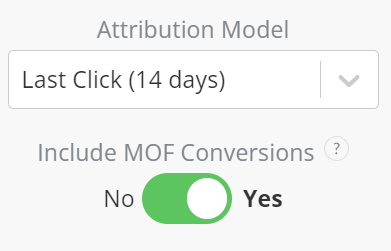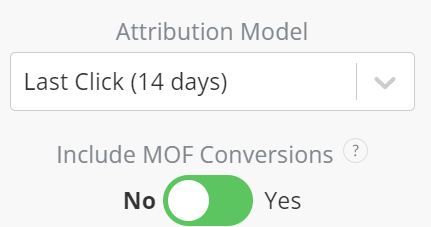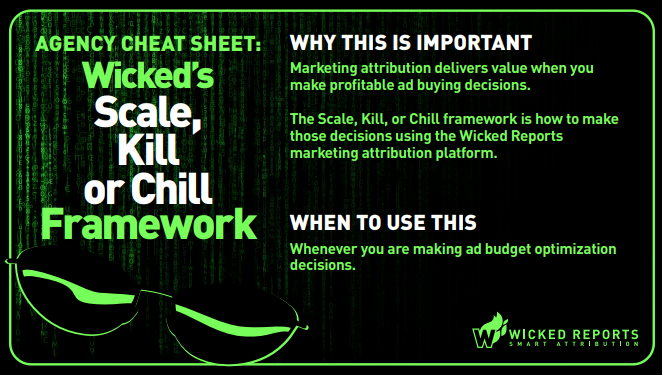The Scale/Kill/Chill Framework for the ROI Report is the easy-to-implement strategy for paid marketing analysis and optimization.
The Scale/Kill/Chill Framework can be run in the ROI Report on Top of Funnel (TOF), Middle of Funnel (MOF) or Bottom of Funnel (BOF) campaigns and ads.
To run the frame-work you initially need a few pieces of information, which you can get by running through the Pre-Optimization Checklist.
Note: Click here to see the Pre-Optimization Checklist
From the Pre-Optimization Checklist, you will get:
- Forecasted Campaign Evaluation Time
- Future Customer LTV Impact
Using the ROI Reports, you will want to run the Scale/Kill/Chill framework for all of your campaigns, but we suggest starting with a Low ROI/ROAS campaign. This is because you can sometimes find nuggets of Positive ROI/ROAS inside poor performing campaigns and it's a wonderful win to begin optimizing campaigns that may overall, be losing you money.
First we need to ensure we're using the proper attribution model.
For the purposes of this playbook, let's start with the Facebook Channel. You will eventually want to run this framework on all paid channels.
Top Of Funnel (TOF) Campaign
What is the Intent of the Campaign?
Brand Awareness: First Click Attribution
If the campaign focuses on brand awareness and simply driving traffic to your site/page without doing lead generation, then we suggest selecting First Click ROI Attribution
This means that we will give credit to the first tracked click of a contact. This click receives 100% credit for all future sales this person

Lead Generation: First Optin Attribution
If the campaign focuses on lead generation and drives traffic to your site/page to acquires new leads, then we suggest selecting First Optin Attribution
This means that we will give credit to the last tracked click prior to the creation of a contact. This click receives 100% credit for all future sales this person makes.

Middle Of Funnel (MOF) Campaign
To Analyze MOF Campaigns, you will select Last Click attribution with "Include MOF Conversions" On
This means that along with all the Last Click sales for a campaign, you will see additional columns and data for the Additional MOF Conversions those same campaigns should get some credit for.
If an order received any click after the contact was created and within 30 days of the order and it wasn't the last click, we consider it a Middle of Funnel Click.
This option will ensure you're actually seeing all the potential sales coming from the campaign, even if it isn't the actual last click.

Bottom Of Funnel (BOF) Campaign
Bottom of Funnel campaigns are best analyzed using Last Click attribution.
This means that we will give credit to the last tracked click, prior to a sale. This is the click with immediate impact on the conversion.
For a more optimistic analysis, you may choose to include Middle of Funnel (MOF) Conversions to ensure you're actually seeing all the potential sales coming from the campaign, even if it isn't the actual last click. It's up to you if you'd like to see the MOF Conversions with your BOF Sales.

Now that you've selected the appropriate attribution model for your campaign, we can begin the process.
We'll start at the Ad level level and work our way back up to the campaigns. We do this because many times, a campaign can look bad and have low ROI/ROAS but within that campaign lives an Ad Set or Ad that is really performing well.
Cutting an entire campaign because it has low ROI/ROAS could result in losing very high performing ads.
Similarly, a campaign with good ROI/ROAS may have Ad Sets and Ads within it dragging the ROI/ROAS down and optimization can really help.
Our goal is to find as many of these nuggets as possible.
1. Select a Low ROI/ROAS campaign to start with
2. Scroll across the grid to find the First Click Date
If you don't see this column, you can add it from the "Manage Columns" button
Use the Forecasted Campaign Evaluation Time (from the Pre-Optimization Checklist), has this campaign been running long enough? If not, pick a different campaign that has been running long enough and continue
3. For the campaign you will be analyzing, drill down into the Ad Sets. Select one Ad Set to start with and drill down into the Ads
4. For the Ad you will start with, how would you describe the ROI/ROAS?
Below Target ROI/ROAS: Unacceptable
Close to Target ROI/ROAS: Average
Above Target ROI/ROAS: Acceptable

Acceptable ROI/ROAS
The Ad already has Acceptable ROI/ROAS, we suggest you SCALE It.
Average ROI/ROAS
What is your Customer LTV Impact
Low LTV Impact
This Ad has Average ROI/ROAS and you have a Low Customer LTV Impact. We suggest you CHILL it and revisit it again after more time has passed.
Moderate LTV Impact
This Ad has Average ROI/ROAS and you have a Moderate Customer LTV Impact. We suggest you CHILL it and revisit it again after more time has passed.
High LTV Impact
This Ad has Average ROI/ROAS and you have a High Customer LTV Impact. We suggest you SCALE it.
Unacceptable ROI/ROAS
What is your Customer LTV Impact
Low LTV Impact
This Ad has Unacceptable ROI/ROAS and you have a Low Customer LTV Impact. We suggest you KILL it and revisit it again after more time has passed.
Moderate LTV Impact
This Ad has Unacceptable ROI/ROAS and you have a Moderate Customer LTV Impact. We suggest you KILL it and revisit it again after more time has passed.
High LTV Impact
This Ad has Unacceptable ROI/ROAS and you have a High Customer LTV Impact. We suggest you CHILL it.
You'll want to run the SCALE/KILL/CHLL method on all Ads. We suggest going through the process on a few more ads before going ahead on your own.

